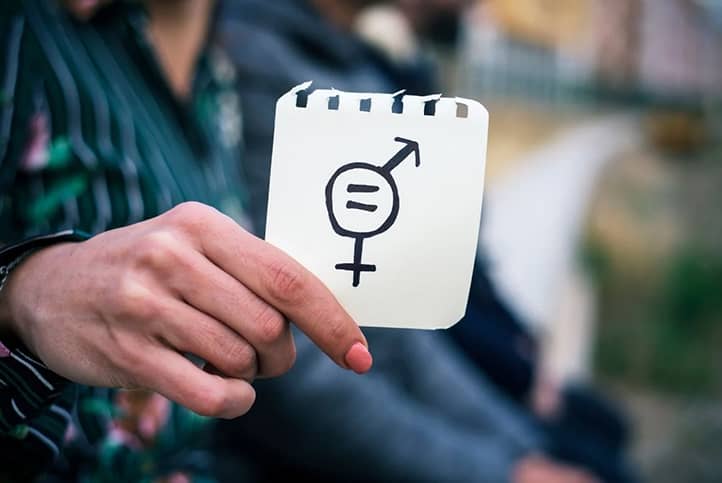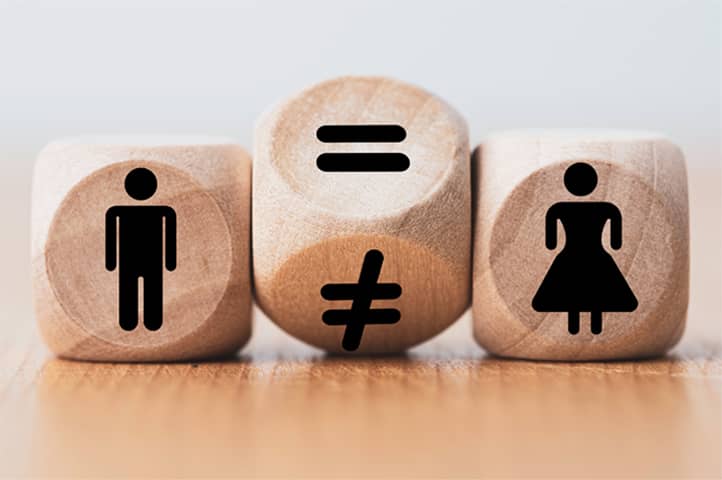Sexism is a system of prejudices and discrimination based on gender, ingrained in societal norms, culture, language, and even laws. This phenomenon is not limited to direct infringement of rights but also operates through stereotypes that shape people’s perceptions and impose restrictions on their self-realization.
Sexism affects all aspects of life, from careers and education to family relationships and social roles. Discussing this issue is essential, as only by recognizing the problem can we begin to address it, dismantling barriers that often remain invisible yet profoundly impact everyone’s lives.
This issue significantly influences opportunities in various spheres of life. For instance, in the professional world, women often face the “glass ceiling” — a situation where gender biases make it harder for them to attain leadership positions. Men, on the other hand, may experience pressure from stereotypes that discourage them from pursuing careers considered “untypical” for their gender, such as caregiving roles.
Education is no exception. From an early age, children encounter expectations that shape their futures. Boys are frequently told they must be “strong” and avoid showing emotion, while girls are encouraged to be obedient and focus on family-oriented roles.
In sports, scientific research, politics, and even culture, sexism establishes invisible boundaries defining what is “normal” or “acceptable” for each gender. For example, female athletes often receive less funding and media attention, while men are viewed as “natural leaders” in politics.
At the same time, these biases do not solely constrain women. Men who wish to take on caregiving roles in families or dedicate themselves to creative pursuits may face ridicule or misunderstanding. Thus, sexism affects society as a whole, creating barriers to equal opportunities and mutual understanding.
Sexism is not only an ethical issue but also an economic and social challenge. In a world where half the population cannot fully realize their potential due to stereotypes, society loses enormous resources, talents, and opportunities for development. Addressing sexism is the first step toward building a fairer and more equitable world where everyone is heard and valued, regardless of gender.

Forms of Sexism
Sexism manifests in various forms and areas of life, ranging from overt discrimination to subtler, yet equally harmful, expressions. These forms range from explicit restrictions based on gender to hidden phenomena embedded in cultural, social, and economic structures.
To understand not only the scale and depth of sexism but also its mechanisms of influence, it is crucial to examine how it manifests, what sustains it, and how it impacts different aspects of people’s lives. Examples from work, education, and sports vividly demonstrate how discrimination becomes entrenched in everyday life.
Direct and Indirect Sexism
- Direct sexism is an overt form of discrimination, where gender-based restrictions or biases are explicitly expressed. For example, when women are denied employment because an employer assumes they are “less productive” due to the possibility of maternity leave. Direct sexism is easy to recognize, as it is based on clear statements or actions. Another example is when men are ridiculed for choosing professions associated with childcare, such as working in kindergartens.
- Indirect sexism, on the other hand, operates more subtly and is often hidden in structures or practices that seem neutral at first glance. For instance, if leadership positions are predominantly given to men because the criteria for evaluating candidates rely on “traditional” leadership qualities historically associated with men, this constitutes indirect sexism. It also manifests through gender expectations, such as offering women only administrative or support roles, even when their qualifications align with more responsible positions.
Stereotypes, Microaggressions, and Systemic Barriers
- Stereotypes are a key mechanism sustaining sexism. They impose rigid frameworks for behavior and choices, such as the belief that women are “naturally” less adept at sciences or that men “must” be the primary family providers. These stereotypes are instilled from childhood through upbringing, toys, media, and education, subconsciously influencing perceptions of oneself and others.
- Microaggressions are seemingly minor actions or statements that may appear harmless but have a profound impact. For example, comments like “You’re surprisingly good at tech for a girl” or “Men don’t cry” reinforce ideas of “proper” behavior for each gender. These microaggressions create discomfort and perpetuate discrimination, even if their authors do not intend to offend.
- Systemic barriers are embedded in societal structures. For example, maternity leave policies that primarily focus on women reinforce the idea that childcare is solely their responsibility. Another example is the disparity in access to funding for female entrepreneurs, as investors often favor men due to biases about their “business acumen.”
Real-Life Examples
- In the workplace, sexism manifests as wage gaps, underrepresentation of women in leadership roles, and stereotypes about job roles. Women are often relegated to supportive positions, while men are given more opportunities for career advancement.
- In education, sexism can be seen in the subjects suggested for boys and girls. Girls are frequently steered toward humanities, while boys are encouraged to pursue technical or natural sciences, creating inequality even during the preparation stage for professional life.
- In sports, women face less media coverage, lower earnings, and general undervaluation of their achievements. For instance, women’s football matches are rarely broadcast on television, and prize funds for female athletes in tournaments are significantly smaller than those for men.
All these examples illustrate how sexism impacts daily life, creating barriers that limit people’s opportunities regardless of their gender. Understanding these forms is the first step toward overcoming them.

How Does Sexism Impact Society?
Sexism is not just about isolated incidents of discrimination; it is a systemic issue that affects all aspects of societal life. It shapes cultural and social norms, restricting individual freedom and opportunities for self-realization. Gender biases lead to inequality in professional environments, domestic life, education, and even political processes. Both women and men experience the consequences of sexism, as stereotypes impose limitations on everyone.
This problem has a profound impact on society as a whole, as restricting the potential of one segment of the population hinders the development of the entire community. In the professional sphere, this results in the loss of talented individuals unable to thrive due to gender barriers. Socially, sexism perpetuates inequality, leading to conflicts and reduced trust among people. Economically, discrimination results in the inefficient use of human resources, further slowing growth and progress.
Limitations for Women
Women frequently encounter barriers in their professional lives. The “glass ceiling” remains one of the most common issues. Despite comprising a significant part of the workforce, women are underrepresented in leadership positions. For example, in many companies, senior roles are traditionally held by men, while women are often perceived as less “ambitious” or “reliable” due to potential maternity leave. Additionally, the gender pay gap is a clear manifestation of discrimination, with women earning less than men for the same work.
In social life, women are burdened with roles imposed by stereotypes. Society often expects women to be the primary caregivers in families, which places a disproportionate share of domestic responsibilities on them. This creates a “double burden” where women must balance professional work with the majority of household duties.
Women also face personal limitations, often subjected to criticism for choices that deviate from traditional roles. For instance, they may be judged for not wanting children or prioritizing their careers over family. These pressures add psychological stress, impacting their well-being and self-confidence.
Limitations for Men
While women are more frequently the victims of sexism, men are also affected by rigid gender expectations. One of the most common stereotypes is that men must be the “breadwinners” and refrain from showing emotions. This limits their freedom to choose professions, lifestyles, and even ways of expressing feelings. For instance, men pursuing careers in caregiving fields, such as teaching or nursing, often face ridicule or disdain.
Society also stigmatizes men who choose to stay home and care for children while their partners work. This creates guilt or shame for making choices that defy traditional gender norms. Additionally, men are less likely to seek psychological help, fearing they will appear “weak” or “incompetent.”
These role-based restrictions not only negatively impact men’s personal lives but also reinforce broader gender inequality by perpetuating traditional norms and roles.
The Economic Impact of Sexism: How Bias Hinders Development
Sexism has a significant negative impact on the economy. Gender inequality in employment, wages, and access to resources results in the underutilization of human potential. For example, when women are denied equal access to leadership roles or entrepreneurial opportunities, society loses valuable leaders and innovators.
Discrimination also reduces workplace productivity. In environments where sexism prevails, employees often experience stress and dissatisfaction, which negatively affects their efficiency. Studies indicate that countries with higher gender equality levels achieve greater economic development, as including everyone in economic activity fosters innovation and growth.
Biases also impact education, a critical driver of economic success. When girls are discouraged from pursuing technical or higher education due to stereotypes, it limits societal potential in the long run. Investing in equal education and employment opportunities for both women and men is not only a matter of fairness but also an effective way to stimulate economic growth.

The Invisibility of the Problem
Sexism is one of the most widespread forms of discrimination, yet many people fail to recognize its existence or significance. This issue often remains invisible due to its deep roots in culture, traditions, and social norms. In many cases, sexism is not perceived as discrimination but is instead seen as “normal” behavior or a “natural” state of affairs.
One reason for the invisibility of sexism is that many of its manifestations appear commonplace and acceptable. People often fail to reflect on how gender stereotypes shape their perceptions of themselves and others. Moreover, society becomes accustomed to certain behaviors and prejudices, which are passed down from generation to generation, creating a kind of “cultural backdrop.” This familiarity makes it difficult to recognize sexism even in situations where it is clearly present.
To make the issue visible, it is essential to examine the mechanisms that obscure its existence and explore real-life examples that demonstrate how sexism goes unnoticed in everyday life.
Why Do Many People Fail to Notice Sexism?
One of the main reasons sexism remains unnoticed is the normalization of stereotypes and biases. In many cultures, gender roles have been established for so long that fulfilling them is considered natural. For instance, the idea that women should take care of the household while men earn a living is seen as a “traditional family model.” People raised with these beliefs may not even realize that such expectations limit opportunities for both genders.
Additionally, sexism often disguises itself as “good intentions” or jokes. For example, comments like “Women are just better at handling household chores” may sound like a compliment but actually reinforce gender stereotypes. Such remarks are often viewed as harmless, so they go unnoticed.
There is also a lack of education on gender equality. Many people simply do not understand how sexism impacts society and therefore fail to see why it is a problem. Combined with a reluctance to acknowledge that discrimination might be part of their own lives, this leads to the issue being ignored.
Mechanisms of Societal Adaptation to Stereotypes
Adaptation to sexist stereotypes begins in early childhood. From a young age, children are exposed to stereotypical ideas about what is “masculine” and “feminine.” For example, boys are encouraged to play with cars and building sets, while girls are given dolls and kitchen sets. These toys shape their understanding of the roles they are expected to fulfill in the future.
The school system often reinforces these stereotypes. For instance, teachers may subconsciously encourage boys to engage more in STEM subjects while steering girls toward the humanities. This approach perpetuates the belief that certain fields are more suitable for one gender than the other.
Media and advertising also play a significant role in sustaining sexist norms. Female representations in advertisements are often reduced to homemakers or objects of sexual desire, while men are portrayed as strong, successful, and authoritative. These messages are so deeply ingrained in culture that they are taken for granted and rarely questioned.
Everyday Examples Where Sexism Appears “Normal”
In many situations, sexism is so habitual that it is almost impossible to notice without deliberate analysis. For instance, in the workplace, women are often asked to perform “supportive” tasks, such as organizing events or taking meeting notes, even when these duties are not part of their job description. Men, in such scenarios, are asked to do these tasks far less frequently.
Another example is phrases that seem innocent but carry sexist undertones. For example, a confident and assertive woman might be described as “too ambitious,” whereas similar behavior in a man is seen as “normal.”
Sexism is also evident in appearance expectations. For instance, women are often criticized for not wearing makeup at work, while men face no such requirements. This creates additional pressure and fosters the notion that women must meet certain standards to be taken seriously.
In family life, sexism often goes unnoticed as well. For example, many people assume that childcare and household responsibilities automatically fall under the “domain” of women, even if they work full-time like their male partners. This approach not only limits women’s opportunities but also increases stress and tension within the family.
The invisibility of sexism results from its normalization in culture and daily life. Adaptation to stereotypes starts in childhood and is reinforced by education, media, and social norms. To overcome this issue, it is crucial not only to recognize its manifestations but also to openly discuss their impact on society, challenging the perception of what is considered “normal.”

How to Combat Sexism?
Sexism is a deeply ingrained problem in many aspects of social life. However, this does not mean it is insurmountable. Efforts to overcome sexism must address multiple levels, from education and changes in the media to implementing legal reforms and taking active individual actions. A comprehensive approach can not only reduce manifestations of sexism but also create conditions for a society where everyone feels equal and protected.
Education and Critical Thinking: Teaching Equality from an Early Age
Education is the foundation of combating sexism. From a young age, children should learn that all people are equal, regardless of gender. This can be achieved by integrating gender equality principles into educational programs and revising parenting approaches.
Parents and teachers play a key role in this process. For instance, it is crucial to avoid stereotypical distribution of activities and roles among children, such as the belief that “boys are stronger and should play sports” while “girls should be polite and care for others.” Instead, children should be encouraged to choose activities based on their interests, not societal expectations.
Developing critical thinking is also an essential component. Children and teenagers need to learn how to analyze the information they receive, question stereotypes, and recognize biases. This will help them avoid automatically accepting sexist ideas and form their own progressive views.
The Role of Media: Promoting Positive Role Models
Media is one of the most influential tools in shaping societal norms. Unfortunately, sexism is prevalent in many modern films, TV shows, advertisements, and other media products. However, media has the potential to change these perceptions by creating positive role models.
First, it is important to avoid gender stereotypes in character portrayal. For example, women should not be reduced to roles of “weak” or “secondary” characters, while men are depicted as “heroes” and “leaders.” Instead, diverse and multifaceted characters should be presented, showcasing the variety of personalities and opportunities available to both genders.
Second, media should be used to promote equality. Campaigns aimed at combating sexism can raise public awareness and stimulate discussion on the issue. For example, advertisements showing men actively involved in parenting or women successfully leading companies can help break stereotypes.
Moreover, journalists and content creators should responsibly approach the production of materials, avoiding language that reinforces sexist perceptions. In this context, training for media professionals can become an important step in fighting discrimination.
Politics and Laws: The Need for Legal Changes
The legal framework plays a decisive role in combating sexism. Clear laws protecting people’s rights and prohibiting discrimination are the foundation for creating an equal society.
One key area is ensuring equal pay for men and women. In many countries, there is still a significant gender pay gap for the same work. Legislative measures requiring pay transparency and penalizing discrimination can significantly change the situation.
Another critical aspect is ensuring equal access to education and jobs. Laws requiring employers to consider gender equality during recruitment help reduce biases.
Furthermore, it is essential to combat sexism at the level of state policy. For example, campaigns against domestic violence and sexual harassment should be accompanied by strict legal sanctions. Governments should create programs aimed at supporting victims of discrimination and gender-based violence.
The Importance of Individual Actions: What Each of Us Can Do
Despite the importance of systemic changes, every individual can contribute to combating sexism. First and foremost, this begins with analyzing one’s own biases. Reflect on which stereotypes you may be perpetuating and consciously reject them.
It is also important to actively oppose sexism when encountered in everyday life. For example, if you hear discriminatory jokes or statements, express your disagreement. Although this may seem challenging, even small acts of resistance contribute to change.
Additionally, everyone can support equality in their environment. Employers can create inclusive workplace conditions, parents can raise children without stereotypes, and consumers can support companies that promote equality.
Sexism is a problem that requires efforts from the entire society. Education, media, politics, and individual actions together can create conditions where equality becomes not just an ideal but a reality. Each of us can be part of this process, making the world fairer and freer for everyone.

Conclusions
Sexism not only limits people’s opportunities but also perpetuates biases that entrench inequality on all levels—from personal to global. This problem affects everyone, as inequality in any form hinders the progress and development of society. Overcoming sexism is not just a fight for the rights of specific groups but a global challenge that concerns every individual, regardless of gender.
It is crucial to understand that sexism is not merely a problem for women or men; it is an issue of human dignity and equality. Combating it contributes to creating a world where everyone can realize their potential without prejudice or discrimination. In a society free from sexism, people have more opportunities to collaborate, grow, and achieve common goals. This positively impacts all areas of life, including the economy, politics, culture, and personal relationships.
However, the fight against sexism begins with each of us. To change the world, we must start by changing ourselves. Supporting equality in everyday actions, rejecting biases, and taking an active stance against discriminatory statements or behaviors are significant steps toward building a new society. Sexism can be overcome if we all work together. It is important not to remain indifferent but to contribute to creating a world where discrimination has no place.




